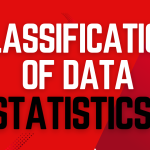Table of Contents
Introduction
Statistics is the science of collecting, organizing, and analyzing data. To study any concept in statistics, the first step is to understand the types of data.
1. Qualitative Data (Categorical Data)
- Definition: Non-numeric data that describes attributes or categories.
- Examples:
- Gender: Male / Female
- Colors: Red, Blue, Green
- Blood Group: A, B, AB, O
👉 Used when data is divided into categories.
2. Quantitative Data (Numerical Data)
- Definition: Data that represents numbers and quantities.
- Examples:
- Age of students: 12, 15, 18 years
- Marks in exam: 85, 90, 95
- Income in dollars
Types:
(a) Discrete Data – Whole numbers, cannot be broken down.
- Example: Number of children in a family (2, 3, 4).
(b) Continuous Data – Can take any value within a range (decimals possible).
- Example: Height (165.7 cm), Weight (55.3 kg).
3. Primary vs. Secondary Data
- Primary Data: Collected directly by the researcher.
- Example: Surveys, Interviews.
- Secondary Data: Collected by someone else, already available.
- Example: Census reports, Govt publications.
4. Data Based on Measurement Scales
- Nominal Scale: Categories only (e.g., Gender, Blood group).
- Ordinal Scale: Categories with ranking order (e.g., Rank: 1st, 2nd, 3rd).
- Interval Scale: Equal intervals, but no true zero (e.g., Temperature in °C).
- Ratio Scale: Equal intervals with true zero (e.g., Height, Weight, Age).
Quick Table
| Type | Examples |
|---|---|
| Qualitative | Gender, Blood Group |
| Quantitative (Discrete) | No. of Students |
| Quantitative (Continuous) | Height, Weight |
| Primary | Survey, Interview |
| Secondary | Census Data |
Importance in Exams
- Many competitive exams (SSC, UPSC, Banking, RPSC, etc.) ask direct questions from this topic.
- Sample Question:
Q: Blood group belongs to which type of data?- (A) Qualitative
- (B) Quantitative
✅ Answer: (A) Qualitative
FAQs
Q1. What is the difference between qualitative and quantitative data?
- Qualitative = Categories, non-numeric.
- Quantitative = Numeric values.
Q2. Is Height discrete or continuous data?
- Continuous.
Q3. Which scale is used for Temperature in Celsius?
- Interval scale.
Conclusion
Understanding types of data in statistics is the foundation of data analysis and research.
- Qualitative = Categories
- Quantitative = Numbers
- Scales = Nominal, Ordinal, Interval, Ratio
This knowledge is essential for competitive exams and real-world data analysis.

